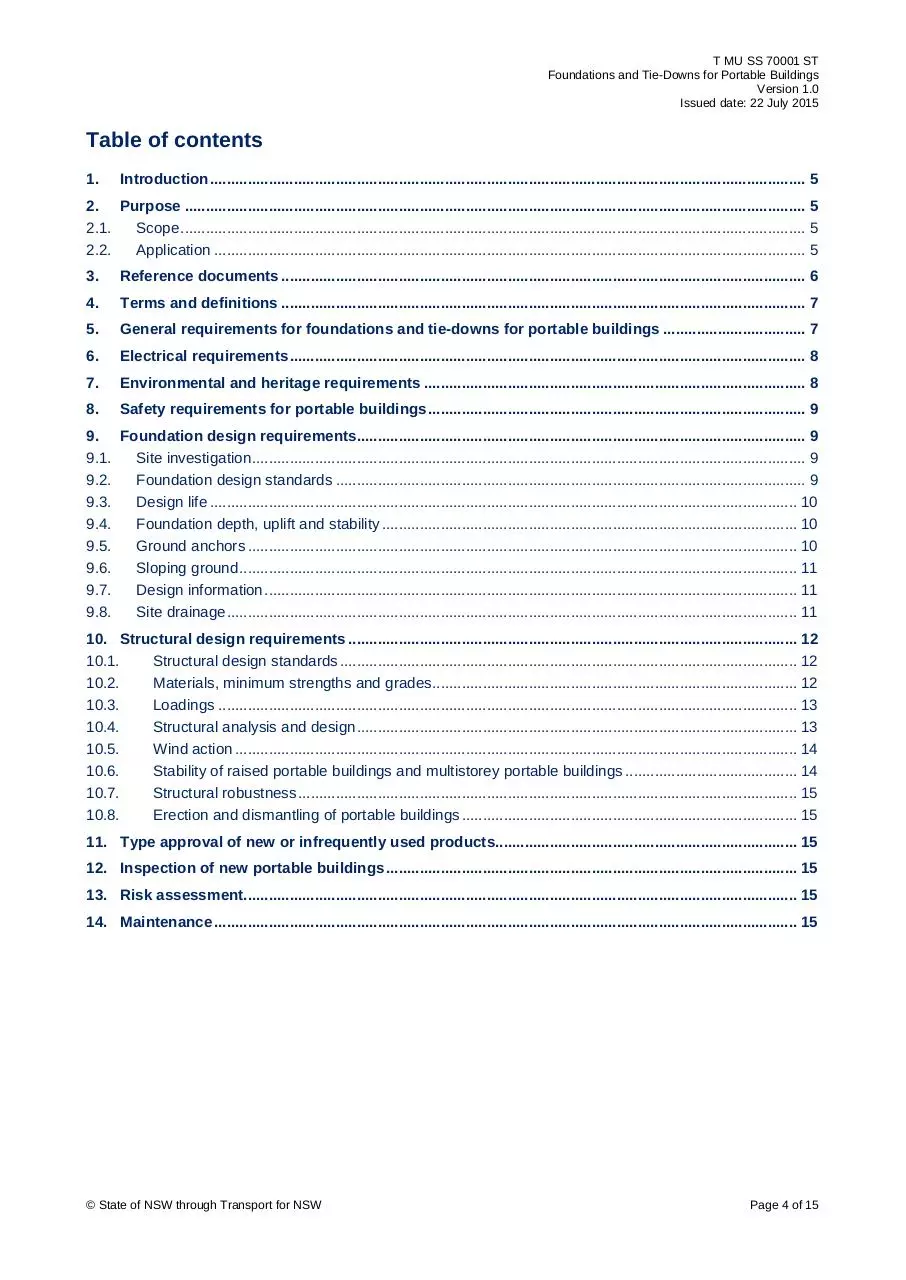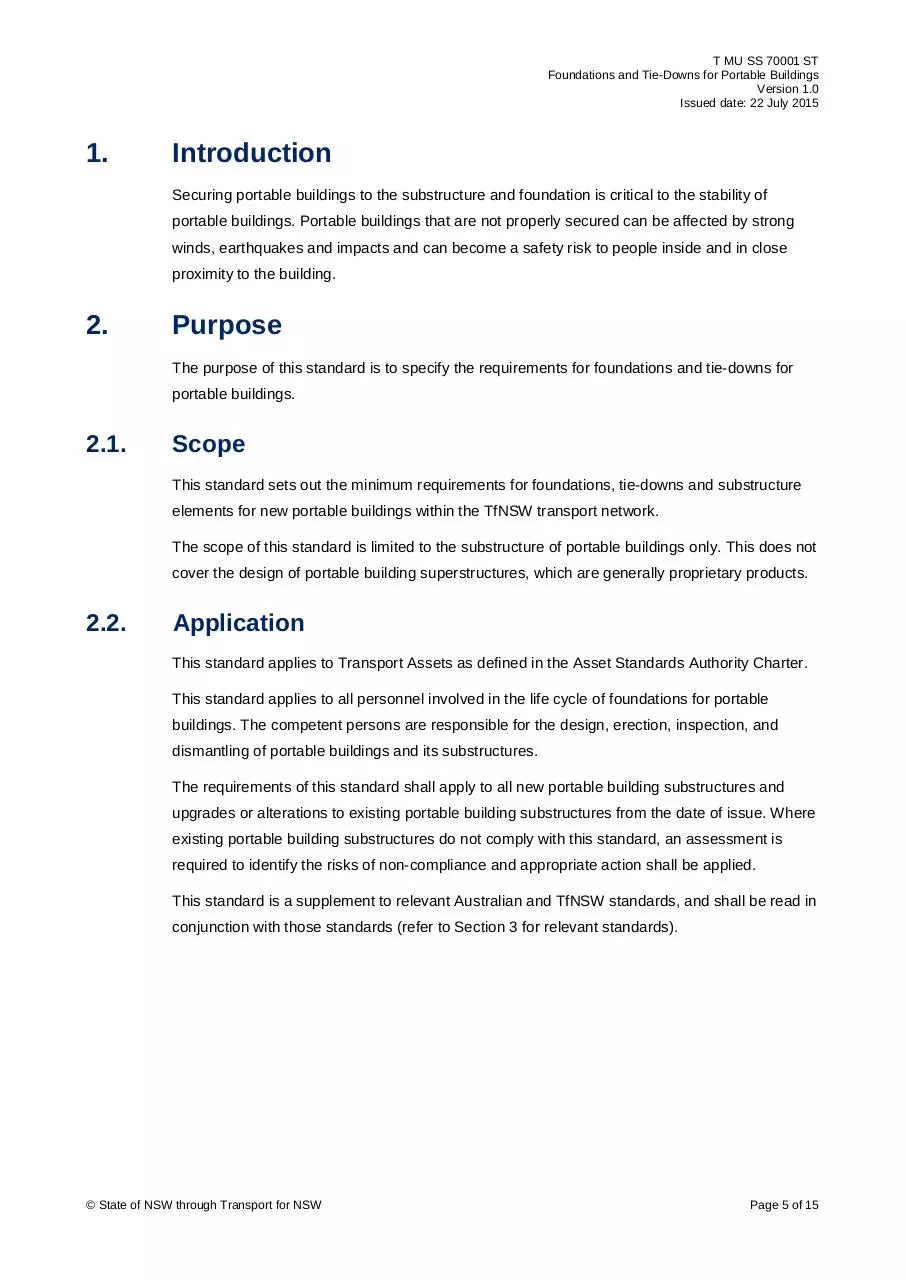t mu ss 70001 st (PDF)
File information
Title: T MU SS 70001 ST Foundations and Tie-Downs for Portable Buildings
Author: Lead Stations and Buildings Engineer, Asset Standards Authority
This PDF 1.6 document has been generated by Acrobat PDFMaker 11 for Word / Adobe PDF Library 11.0, and has been sent on pdf-archive.com on 23/11/2015 at 16:29, from IP address 104.222.x.x.
The current document download page has been viewed 755 times.
File size: 198.94 KB (15 pages).
Privacy: public file





File preview
T MU SS 70001 ST
Standard
Foundations and Tie-Downs for
Portable Buildings
Version 1.0
Issued date: 22 July 2015
Important Warning
This document is one of a set of standards developed solely and specifically for use on public transport assets which are vested in or
owned, managed, controlled, commissioned or funded by the NSW Government, a NSW Government agency or a Transport Agency
(as defined in the Asset Standards Authority Charter). It is not suitable for any other purpose.
You must not use or adapt it or rely upon it in any way unless you are authorised in writing to do so by a relevant NSW Government
agency. If this document forms part of a contract with, or is a condition of approval by a NSW Government agency, use of the document
is subject to the terms of the contract or approval.
This document may not be current. Current standards are available for download from the Asset Standards Authority website at
www.asa.transport.nsw.gov.au.
© State of NSW through Transport for NSW
T MU SS 70001 ST
Foundations and Tie-Downs for Portable Buildings
Version 1.0
Issued date: 22 July 2015
Standard governance
Owner:
Lead Stations and Buildings Engineer, Asset Standards Authority
Authoriser:
Chief Engineer Rail, Asset Standards Authority
Approver:
Director, Asset Standards Authority on behalf of the ASA Configuration Control Board
Document history
Version
Summary of Changes
1.0
First issue
For queries regarding this document,
please email the ASA at
standards@transport.nsw.gov.au
or visit www.asa.transport.nsw.gov.au
© State of NSW through Transport for NSW
T MU SS 70001 ST
Foundations and Tie-Downs for Portable Buildings
Version 1.0
Issued date: 22 July 2015
Preface
The Asset Standards Authority (ASA) is an independent unit within Transport for NSW (TfNSW)
and is the network design and standards authority for defined NSW transport assets.
The ASA is responsible for developing engineering governance frameworks to support industry
delivery in the assurance of design, safety, integrity, construction, and commissioning of
transport assets for the whole asset life cycle. In order to achieve this, the ASA effectively
discharges obligations as the authority for various technical, process, and planning matters
across the asset life cycle.
The ASA collaborates with industry using stakeholder engagement activities to assist in
achieving its mission. These activities help align the ASA to broader government expectations
of making it clearer, simpler, and more attractive to do business within the NSW transport
industry, allowing the supply chain to deliver safe, efficient, and competent transport services.
The ASA develops, maintains, controls, and publishes a suite of standards and other
documentation for transport assets of TfNSW. Further, the ASA ensures that these standards
are performance-based to create opportunities for innovation and improve access to a broader
competitive supply chain.
This standard sets the minimum requirements for foundations, tie-downs and substructure
elements for portable buildings. It has been developed through consultation with stakeholders
across TfNSW.
This standard is a first issue.
© State of NSW through Transport for NSW
Page 3 of 15
T MU SS 70001 ST
Foundations and Tie-Downs for Portable Buildings
Version 1.0
Issued date: 22 July 2015
Table of contents
1.
Introduction .............................................................................................................................................. 5
2. Purpose .................................................................................................................................................... 5
2.1.
Scope ..................................................................................................................................................... 5
2.2.
Application ............................................................................................................................................. 5
3.
Reference documents ............................................................................................................................. 6
4.
Terms and definitions ............................................................................................................................. 7
5.
General requirements for foundations and tiedowns for portable buildings .................................. 7
6.
Electrical requirements ........................................................................................................................... 8
7.
Environmental and heritage requirements ........................................................................................... 8
8.
Safety requirements for portable buildings .......................................................................................... 9
9. Foundation design requirements........................................................................................................... 9
9.1.
Site investigation .................................................................................................................................... 9
9.2.
Foundation design standards ................................................................................................................ 9
9.3.
Design life ............................................................................................................................................ 10
9.4.
Foundation depth, uplift and stability ................................................................................................... 10
9.5.
Ground anchors ................................................................................................................................... 10
9.6.
Sloping ground ..................................................................................................................................... 11
9.7.
Design information ............................................................................................................................... 11
9.8.
Site drainage ........................................................................................................................................ 11
10. Structural design requirements ........................................................................................................... 12
10.1.
Structural design standards ............................................................................................................. 12
10.2.
Materials, minimum strengths and grades ....................................................................................... 12
10.3.
Loadings .......................................................................................................................................... 13
10.4.
Structural analysis and design ......................................................................................................... 13
10.5.
Wind action ...................................................................................................................................... 14
10.6.
Stability of raised portable buildings and multistorey portable buildings ......................................... 14
10.7.
Structural robustness ....................................................................................................................... 15
10.8.
Erection and dismantling of portable buildings ................................................................................ 15
11. Type approval of new or infrequently used products........................................................................ 15
12. Inspection of new portable buildings .................................................................................................. 15
13. Risk assessment.................................................................................................................................... 15
14. Maintenance ........................................................................................................................................... 15
© State of NSW through Transport for NSW
Page 4 of 15
T MU SS 70001 ST
Foundations and Tie-Downs for Portable Buildings
Version 1.0
Issued date: 22 July 2015
1.
Introduction
Securing portable buildings to the substructure and foundation is critical to the stability of
portable buildings. Portable buildings that are not properly secured can be affected by strong
winds, earthquakes and impacts and can become a safety risk to people inside and in close
proximity to the building.
2.
Purpose
The purpose of this standard is to specify the requirements for foundations and tie-downs for
portable buildings.
2.1.
Scope
This standard sets out the minimum requirements for foundations, tie-downs and substructure
elements for new portable buildings within the TfNSW transport network.
The scope of this standard is limited to the substructure of portable buildings only. This does not
cover the design of portable building superstructures, which are generally proprietary products.
2.2.
Application
This standard applies to Transport Assets as defined in the Asset Standards Authority Charter.
This standard applies to all personnel involved in the life cycle of foundations for portable
buildings. The competent persons are responsible for the design, erection, inspection, and
dismantling of portable buildings and its substructures.
The requirements of this standard shall apply to all new portable building substructures and
upgrades or alterations to existing portable building substructures from the date of issue. Where
existing portable building substructures do not comply with this standard, an assessment is
required to identify the risks of non-compliance and appropriate action shall be applied.
This standard is a supplement to relevant Australian and TfNSW standards, and shall be read in
conjunction with those standards (refer to Section 3 for relevant standards).
© State of NSW through Transport for NSW
Page 5 of 15
T MU SS 70001 ST
Foundations and Tie-Downs for Portable Buildings
Version 1.0
Issued date: 22 July 2015
3.
Reference documents
The following documents are cited in the text. For dated references, only the cited edition
applies. For undated references, the latest edition of the referenced document applies.
Australian standards
AS 1170.4 Structural Design Actions – Part 4: Earthquake Actions in Australia
AS 1726 Geotechnical Site Investigation
AS 2159 Piling – Design and installation
AS 2321 Short-link chain for lifting purposes
AS 2870 Residential Slabs and Footings
AS 3600 Concrete Structures
AS 4100 Steel Structures
AS 4678 Earth Retaining Structures
AS 4797 Stainless steel chain for lifting purposes
AS 5100.2 Bridge design – Design loads
AS 5100.3 Bridge design – Foundations and soil supporting structures
AS/NZS 1170.0 Structural Design Actions – General principles
AS/NZS 1170.1 Structural Design Actions – Part 1: Permanent, Imposed and other Actions
AS/NZS 1170.2 Structural Design Actions –Part 2: Wind Actions
AS/NZS 1170.3 Structural Design Actions – Part 3: Snow and Ice Actions
Transport for NSW standards
EP 12 10 00 21 SP Low voltage installations Earthing
EP 12 20 00 01 SP Bonding of Overhead Wiring Structures to Rail
ESC 215 Transit Space
ESB E001 Low Voltage Electrical Standard
SPC 301 Structures Construction
T HR EL 00004 ST Buildings and Structures under Overhead Lines
T HR EL 12002 GU Electrolysis from Stray DC Current
T MU AM 01003 ST Development of Technical Maintenance Plans
© State of NSW through Transport for NSW
Page 6 of 15
T MU SS 70001 ST
Foundations and Tie-Downs for Portable Buildings
Version 1.0
Issued date: 22 July 2015
Legislation
Environmental Planning and Assessment Act 1979 (NSW)
Heritage Act 1977 (NSW)
Work Health and Safety Act 2011 (NSW)
Other reference documents
Asset Standards Authority Charter
National Construction Code Series
4.
Terms and definitions
The following terms and definitions apply in this document:
competent person means a person who has acquired through training, qualifications and
experience the knowledge and skills to carry out the task
NCC National Construction Code
portable building is a building designed and built to be movable rather than permanently
located
SFAIRP so far as is reasonably practicable
TfNSW Transport for New South Wales
Transport Assets means those assets listed in the Asset Standards Authority Charter which
are vested in or owned, managed, controlled, commissioned or funded by the NSW
Government, a NSW Government Agency or a Transport Agency
5.
General requirements for foundations and
tiedowns for portable buildings
All portable building foundations, tie-downs and substructure elements shall be designed in
accordance with the requirements of this standard, the National Construction Code (NCC) and
Australian standards as specified in this document.
Construction materials for foundations, foundation tie-downs, superstructure ties to foundation
piers, connectors, bracings and all other substructure elements shall be made of steel or
reinforced concrete.
The installation of portable buildings within the rail corridor shall comply with horizontal and
vertical clearances outlined in ESC 215 Transit Space.
The specifications detailed in SPC 301 Structures Construction shall be incorporated in the
design and construction documentation of portable buildings.
© State of NSW through Transport for NSW
Page 7 of 15
T MU SS 70001 ST
Foundations and Tie-Downs for Portable Buildings
Version 1.0
Issued date: 22 July 2015
A services search shall be undertaken prior to any works taking place. Foundations and
tiedowns shall be designed in such a way that they are clear from all underground services and
will not affect the integrity of those services.
6.
Electrical requirements
The design and siting of portable buildings shall comply with the following electrical
requirements:
•
T HR EL 00004 ST Buildings and Structures Under Overhead Lines for minimum clearance
requirements to 1500 V dc overhead traction wiring and equipment
•
EP12 20 00 01 SP Bonding of Overhead Wiring Structures to Rail and EP 12 10 00 21 SP
Low Voltage Installations Earthing for touch potential and earthing and bonding
requirements
•
T HR EL 12002 GU Electrolysis from Stray DC Current for requirements regarding the
potential effects of stray electrical currents and electrolysis in the electrified area of the rail
network
7.
•
AS/NZS 3000, AS/NZS 3001 and AS/NZS 3012, as appropriate
•
ESB E001 Low Voltage Electrical Standard
Environmental and heritage requirements
The design and location of portable building substructures shall take into account environmental
impacts over the whole life cycle including the construction, operation, maintenance and
demolition phases with a view to minimise such impacts. The design and location shall consider
sustainability initiatives, such as energy conservation through passive design, sustainable
material selection and water conservation. The Environmental Planning and Assessment Act
1979 shall be complied with.
The Heritage Act 1977 is designed to protect, maintain and manage environmental heritage in
NSW, including items of archaeological significance. When changes are proposed to items that
have heritage significance, the following provisions and principles apply:
•
for items listed on the State Heritage Register, the provisions of the Heritage Act shall be
met
•
for items listed on a state agency Section 170 Heritage and Conservation Register, the
principles and relevant guidelines contained within the State Agency Heritage Guide shall
be followed
Where a portable building is proposed within a heritage listed precinct and in the vicinity of a
heritage listed item, the identified significance of the heritage items shall not be compromised.
© State of NSW through Transport for NSW
Page 8 of 15
T MU SS 70001 ST
Foundations and Tie-Downs for Portable Buildings
Version 1.0
Issued date: 22 July 2015
8.
Safety requirements for portable buildings
The design, construction, operation and demolition of portable building substructures shall
comply with the Work Health and Safety Act 2011. In addition, compliance to the National
Construction Code (NCC) shall apply at all times with regard to the safe design and construction
of all portable building structures.
The siting of portable buildings shall avoid any risk of derailment impacts, risk of the structure
falling onto the track, risk of impacts from road vehicles and risk of impacts from any other
source. A safety risk assessment is required to demonstrate that safety risks are eliminated or
reduced so far as is reasonably practicable (SFAIRP). This could be undertaken as part of the
overall risk management process required in Section 13.
9.
Foundation design requirements
The foundation design shall be carried out by a competent person who has considerable
knowledge of soil and structure interaction, and of the related structural design procedures
using limit state design principles in accordance with the Australian standards appropriate for
the building classification. The building classification shall be determined in accordance with the
NCC.
9.1.
Site investigation
A geotechnical investigation of the proposed site shall be carried out, prior to the
commencement of any foundation design by a competent person in accordance with AS 1726
Geotechnical Site Investigation. A geotechnical investigation shall be undertaken to enable an
accurate profiling of the subsurface condition. The depth of the investigation shall be
undertaken beyond the depth of influence of the proposed foundation system.
9.2.
Foundation design standards
The foundation design shall comply with the following standards:
•
AS 2870 Residential Slabs and Footings
•
AS 2159 Piling – Design and installation
•
AS 4678 Earth Retaining Structures
•
AS 5100.3 Bridge design – Foundations and soil supporting structures (as required)
•
AS 5100.2 Bridge Design – Design Loads (as required)
AS 2870 is applicable for the design of foundations for certain types of non-residential buildings
and allows for the modification of standard designs using engineering principles.
© State of NSW through Transport for NSW
Page 9 of 15
Download t-mu-ss-70001-st
t-mu-ss-70001-st.pdf (PDF, 198.94 KB)
Download PDF
Share this file on social networks
Link to this page
Permanent link
Use the permanent link to the download page to share your document on Facebook, Twitter, LinkedIn, or directly with a contact by e-Mail, Messenger, Whatsapp, Line..
Short link
Use the short link to share your document on Twitter or by text message (SMS)
HTML Code
Copy the following HTML code to share your document on a Website or Blog
QR Code to this page

This file has been shared publicly by a user of PDF Archive.
Document ID: 0000316885.